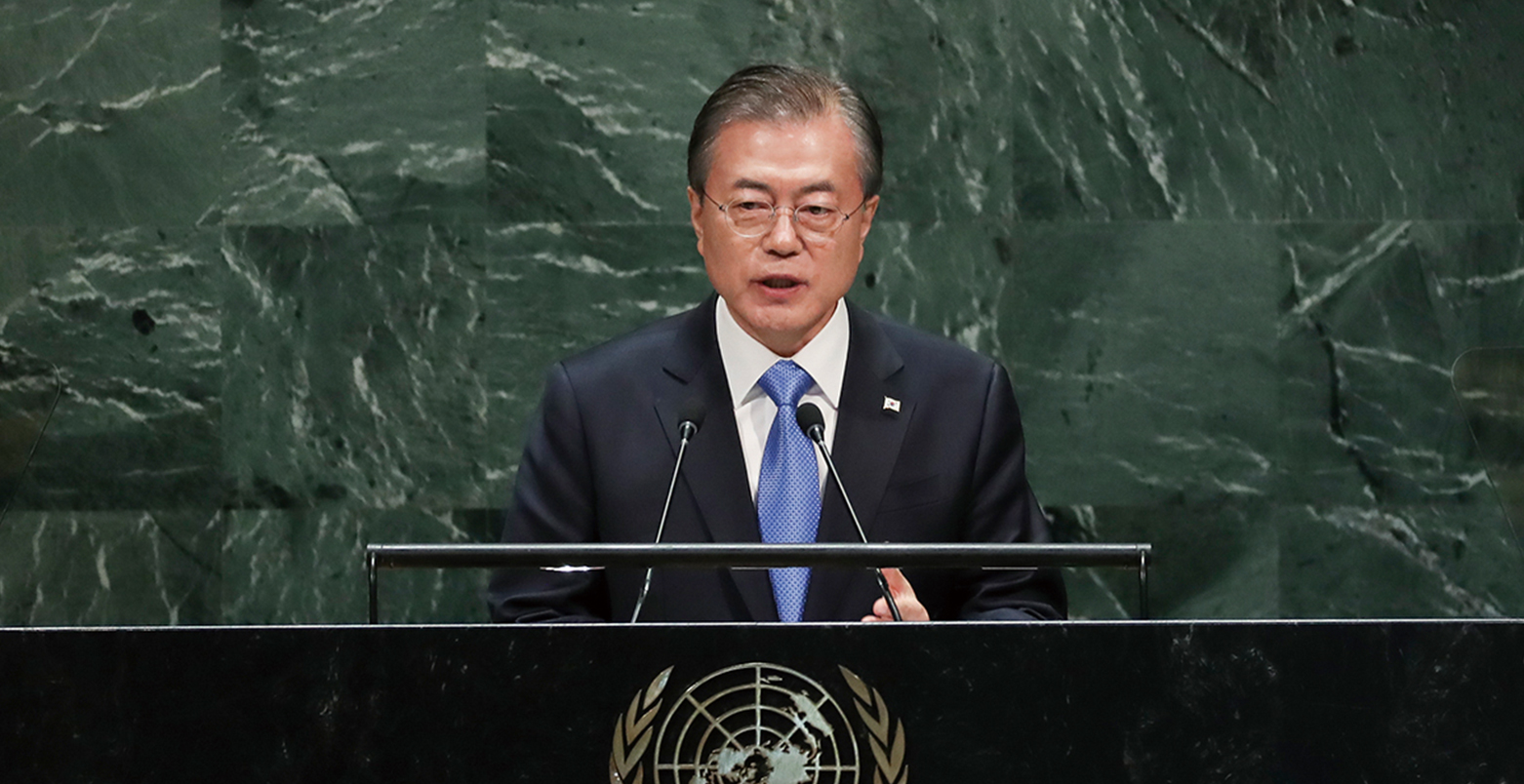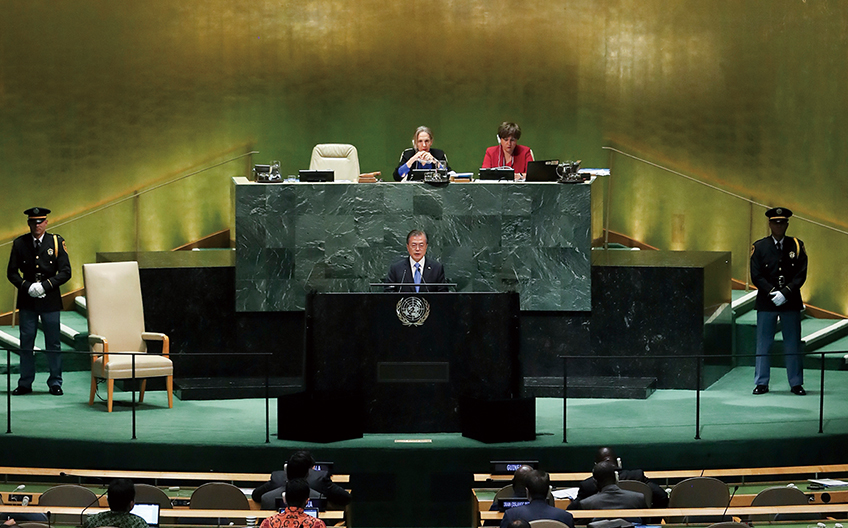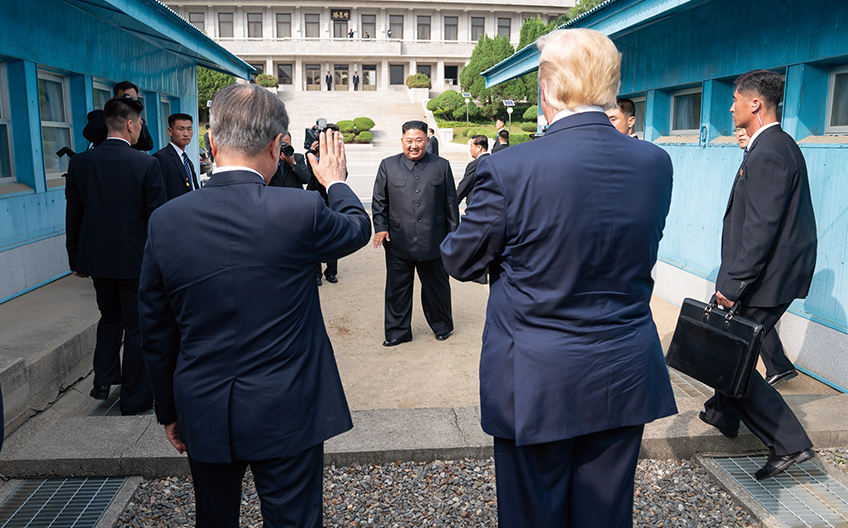
Contents










Current Korea · Written by Sohn Ji-ae Photo courtesy of Cheong Wa Dae and the White House
Turning DMZ into
Int’l Peace Zone
On Sept. 24 in New York, President Moon Jae-in urged world leaders assembled at the U.N. General
Assembly to help the two Koreas make peace, not war, and transform the Demilitarized Zone (DMZ),
the main symbol of inter-Korean confrontation and hostility, into an international peace zone.

Sept. 24: President Moon Jae-in gives a keynote speech at the 74th U.N. General Assembly in New York. © Cheong Wa Dae
The Demilitarized Zone (DMZ) is a vast strip of land across the Korean Peninsula, stretching 250 km from east to west and 4km from north to south. The buffer zone separating the two Koreas for more than 60 years has been a symbol of endless confrontation and division between both sides.
This infamous reputation started to wane, however, when the Moon Jae-in administration came to power in 2017. Under President Moon, historic events have unfolded at the Cold War’s final frontier, from inter-Korean summits at the Panmunjeom truce village to U.S. President Donald Trump crossing the demarcation line to join North Korean leader Kim Jong Un on the North’s soil.
Both Koreas also removed all guard posts inside the zone under a military agreement reached in their summit in Pyeongyang in September last year. With the yearning for peace on the peninsula stronger than ever, the president envisions turning the DMZ into a global peace zone.

President Moon gives his third address to the U.N. General Assembly as Korea’s head of state. © Cheong Wa Dae
Peace Zone Proposal
Speaking on Sept. 24 to the 74th U.N. General Assembly in New York, President Moon made his pitch to world leaders to “transform the DMZ into an international peace zone,” reflecting his thoughts on how to reduce tensions on the peninsula and Pyeongyang’s fears over regime security through international cooperation.
His vision is to designate the area connecting Panmunjeom and the North Korean border city of Gaeseong as a “peace and cooperation district” and making it a zone where both Koreas and the world can jointly pursue prosperity on the peninsula.
President Moon mentioned the U.N. offices stationed in the two Koreas and other international organizations for peace, ecology and culture in the DMZ, and said the zone can emerge as a hub of research on peace, peacekeeping, arms control and trust building. “It can then become an international peace zone in name as well as substance,” he added.
The envisioned zone will be based on the three principles the president has stressed throughout the peace process: zero tolerance for war, mutual security guarantees and co-prosperity.
“When the DMZ that cuts across the midriff of the peninsula is turned into a peace zone, the peninsula will evolve into a bridging nation that connects the continent and the ocean and facilitates peace and prosperity,” he said.

June 30: Presidents Moon Jae-in and Donald Trump wave goodbye to North Korean leader Kim Jong Un after their historic meeting at the truce village of Panmunjeom on the inter-Korean border. © White House
Need for Int’l Support
President Moon hopes for another huge step in cross-border ties to follow the vast strides made in inter-Korean and U.S.-North Korea dialogue over just the past few years. His proposed peace zone is part of his pursuit of international participation and support in the peace process, and he is well aware that without such backing, peace on the peninsula is not possible.
Trump, in his own speech to the General Assembly, asked Pyeongyang to denuclearize while taking an upbeat tone on peace without war. “America’s goal is harmony, and America’s goal is not to go with these endless wars,” he said.
U.N. Secretary-General Antonio Guterres, in his opening speech, also pledged full support for efforts to facilitate another summit between Trump and Kim on the peninsula’s uncertain situation.
The solid support and engagement of world leaders for this peace zone initiative can serve as a major boost to resuming dialogue and rebuilding trust with North Korea.
Other Articles















